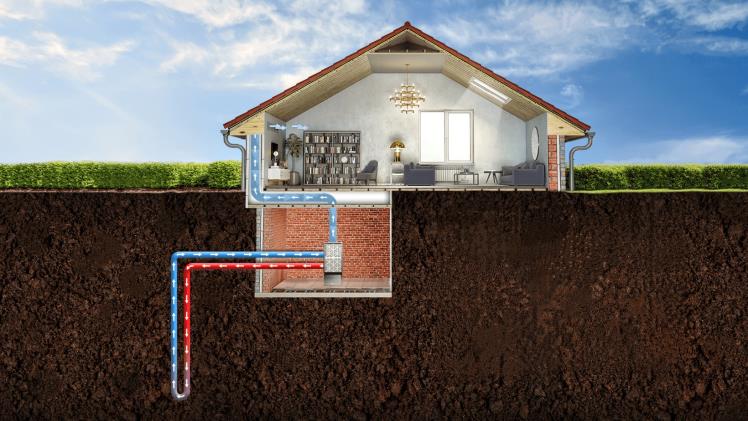In our ongoing pursuit of sustainable energy solutions, geothermal heat pumps (GHPs) have emerged as a game-changer for residential heating and cooling. By tapping into the earth’s stable underground temperatures, GHPs offer an efficient and environmentally friendly alternative to traditional HVAC systems. This blog will explore the unique benefits of geothermal heat pumps and provide a detailed overview of their installation process.
Understanding Geothermal Heat Pumps
Geothermal heat pumps, also known as ground-source heat pumps, utilize the earth’s consistent subterranean temperatures to regulate indoor climate. Unlike air-source heat pumps that rely on fluctuating outdoor air temperatures, GHPs draw on the earth’s stable underground warmth. This leads to significant energy savings and a reduced environmental footprint, making them an attractive option for eco-conscious homeowners.
The Benefits of Geothermal Heat Pumps
- Exceptional Energy Efficiency: Geothermal systems can slash energy consumption by up to 70% compared to conventional heating and cooling systems. This remarkable efficiency results in substantial reductions in utility bills.
- Environmental Friendliness: By harnessing renewable energy from the ground, GHPs significantly cut greenhouse gas emissions, helping mitigate climate change.
- Long-Lasting Durability: With fewer moving parts and protection from harsh weather conditions, GHPs typically have a longer lifespan than conventional systems. Indoor components can last up to 25 years, while the ground loops can last over 50 years.
- Year-Round Comfort: GHPs provide consistent indoor temperatures throughout the year, regardless of external weather conditions, ensuring a comfortable living environment.
- Quiet Operation: Geothermal systems operate with minimal noise, enhancing the tranquility of your home.
Types of Geothermal Heat Pump Systems
The choice of geothermal system largely depends on your property’s characteristics. Here are the main types:
Closed-Loop Systems:
- Horizontal: Pipes are laid in trenches several feet deep. Suitable for properties with sufficient horizontal space.
- Vertical: Pipes are installed in deep boreholes. Ideal for properties with limited horizontal space.
- Pond/Lake: Pipes are submerged in a body of water, utilizing the water as a heat exchange medium.
Open-Loop Systems:
These systems draw groundwater directly for heat exchange and return it to the ground. Effective where groundwater is plentiful.
Installation Process of a Geothermal Heat Pump
Initial Site Evaluation:
Conduct a comprehensive assessment of your property, including soil type, land area, and available water bodies. A professional geothermal contractor can determine the most suitable system for your needs.
System Design:
Develop a tailored system design based on the site evaluation. This includes choosing the type of loop system and determining the appropriate size of the heat pump.
Ensure compliance with local building codes and environmental regulations.
Drilling and Excavation:
For vertical systems, drill deep boreholes; for horizontal systems, dig extensive trenches.
For open-loop systems, install wells or create intake and discharge points in a water source.
Loop Installation:
In closed-loop systems, install high-density polyethylene pipes in the trenches or boreholes and fill them with a heat transfer fluid.
Connect open-loop systems to the groundwater source.
System Integration:
Connect the ground loops to the geothermal heat pump unit inside the home. This involves running pipes from the ground loop to the heat pump and integrating it with the existing ductwork or radiant heating system.
Testing and Optimization:
Thoroughly test the system to ensure it operates correctly. This includes checking loop pressure, heat pump performance, and ensuring there are no leaks.
Balance the system for optimal performance and efficiency.
Ongoing Maintenance:
Regular maintenance is crucial to ensure long-term efficiency. Periodically inspect the heat pump, clean air filters, and check the ground loop system.
Key Considerations for Geothermal Installation
- Initial Investment: Geothermal systems have higher upfront costs compared to traditional HVAC systems. However, federal and state incentives, combined with long-term energy savings, can help offset these initial expenses.
- Professional Expertise: Given the complexity of geothermal installations, hiring a professional contractor is highly recommended.
- Suitability of Property: Not all properties are ideal for geothermal installations. Factors such as available space, soil type, and water availability are critical in determining suitability.
Conclusion
Geothermal heat pumps represent a sustainable, efficient, and long-term solution for residential heating and cooling. Despite the initial complexity and cost of installation, the benefits of reduced energy consumption, lower environmental impact, and significant long-term savings make GHPs an attractive option for homeowners committed to sustainability. By understanding the installation process and key considerations, you can make an informed decision about whether a geothermal heat pump is right for your home.





